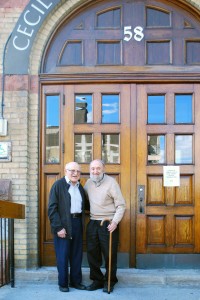
Gurion Hyman and Gordon Perlmutter recreate the 1938 picture that is memorialized on a Heritage Toronto plaque. Unveiled in early July, the plaque, which is the thirteenth to commemorate Toronto’s Jewish her- itage, will be installed in front of the Cecil Street Community Centre. Marcus Mitanis/Heritage Toronto
By Annemarie Brissenden
Heritage Toronto marks Cecil Street Jewish roots
In 1938, two young boys posed for a picture on the front steps of the Ostrovtzer Synagogue at 58 Cecil Street. Three-quarters of a century later, Gurion Hyman and Gordon Perlmutter, now grown men with a wealth of history behind them, stood once more on those same steps on a balmy July evening, recreating the picture for a new generation.
Although the neighbourhood— like the synagogue, which is now a community centre—has changed dramatically in 75 years, signs still re- main of a time when Cecil Street was “institution row” to the city’s growing Jewish community. And, on July 9, Heritage Toronto unveiled “Cecil Street’s Jewish Heritage”, a plaque that commemorates the stretch from Spadina Avenue to Beverly Street. Featuring the 1938 picture, it also includes a map of the area from Goad’s Atlas (fire insurance maps published by Charles Goad) and a picture of the Jewish Old Folks Home, both dated 1923, and a description highlighting some of the local landmarks.
“Cecil Street and the surrounding area was the crucible for our lives,” said Avi Hyman, Gurion Hymon’s son, at the plaque unveiling. He was joined by Brent Pearlman of Heritage Toronto, Adam Nelson of sponsor
Scotiabank, and Eric Slavens, who was on the board of Heritage Toronto for six years and is now the chair of the Ontario Jewish Archives (OJA).
Slavens, who related that one of his grandfathers worked at a hat factory around the corner while another sold newspapers in the neighbourhood, said the area was a “key setting where our collective identity as Jewish Torontonians was framed.”
The area was actually home to the third wave of Jewish settlement in Toronto, which dates back to as early as the 1830s.
“It’s a bit of a misconception that Cecil Street was the first place that Jews settled in,” explained Sharoni Si- bony, an OJA tour guide who led a walk through the neighbourhood after the unveiling. The earliest Jewish immigrants settled around King Street East, closer to the lake and near the Pape Avenue cemetery. The second wave arrived between the late 1800s and early 1900s, and landed in St. John’s Ward, the area that is home to City Hall.
The Ostrovtzer Synagogue—once a church—was purchased in the 1920s and, with that, the area be- came a beacon of Jewish life for over 40 years. It is now the Cecil Street Community Centre, and remnants of the synagogue, like the ladies’ gallery in the auditorium, two plaques in the hallway, and the cor- nerstone marker, are still embedded in the building.
Likewise, signs of the street’s Jewish past are there for all who care to look. One woman on the tour, who grew up in the neighbourhood, re- called going to the Labour Zionist Centre three days a week after school to learn Jewish songs and dances.
“It was a wonderful place to come, but we resented leaving school to go to school,” she said ruefully of the centre, which is now home to the Bethune Institute.
Across the street was the Jewish Old Folks Home. Also pictured on the plaque, it grew from a semi-de- tached home on Cecil Street into Baycrest, a hospital on Bathurst Street that specializes in geriatric care.
A little further down at the end of Cecil Street is the Russian Orthodox Church. Located on Beverly Street, its front faces Institution Row. Orig- inally the Beth Jacobs Synagogue, the building, which dates to 1922, was designed by Benjamin Brown, Toronto’s first Jewish architect, who would go on to design the Balfour building at Adelaide Street West and Spadina Avenue. Seating approxi- mately 200 people, the synagogue not only had a ritual bath but it also featured a retractable roof that was pulled back for use during the autumn festival of Sukkot.
If you look closely, other markers remain, even further afield from Cecil Street.
For example, John’s Italian Cafe on Baldwin Street still has the Yiddish sign from Mendell’s Creamery etched on its windows.
These are but some of the many markers that serve as a reminder of
“how far back [Jewish heritage in Toronto] goes,” as Slavens said, and just “how pervasive it was over time.”
The OJA regularly conducts walking tours of Kensington Market from April to October. For further information, please visit www.ontariojewisharchives.org, and for more information on Heritage Toronto, please visit www.heritagetoronto.org.
